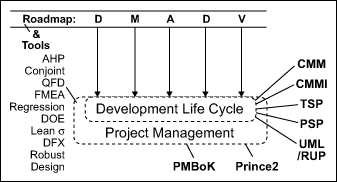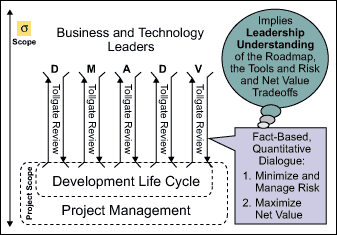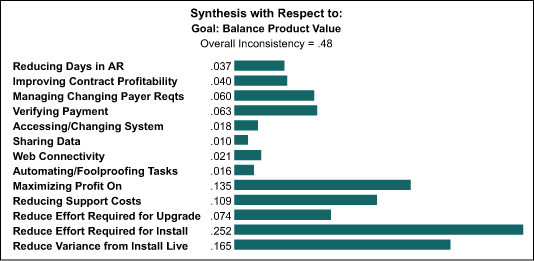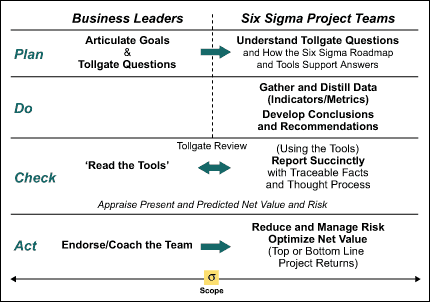
When software developers and project managers begin to learn about Six Sigma, it is natural that their first orientation is from within the processes most familiar to them. Developers looking at Design for Six Sigma (DFSS), for example, will often find a way that it aligns with their software development life cycle (SDLC) and then work to see how the new roadmap and toolkit may add value. From this viewpoint, they may see their domain as “already full” with roadmaps and tools.
They may already be working with the Personal Software Process (PSPSM) and Team Software Process (TSPSM) which align with the development life cycle and include and/or suggest a number of tools. (Personal Software Process, PSP, Team Software Process and TSP are service marks of the Software Engineering Institute [SEI] at Carnegie Mellon University.) Time-honored SEI Capability Maturity Models (CMMSM and CMMISM) suggest best practices that align with both the SDLC and ongoing process management and improvement processes.


Project managers can have the same “already full of tools” problem. Depending on where they work, they probably see the Project Management Body of Knowledge PMBoK, U.S.-based) or Prince 2 (Europe-based) as a compelling roadmap and toolkit that engages a lot of their attention.
While there are places where Six Sigma as “roadmap and tools” can add significant value within software professionals’ existing scope of work, it can be pretty hard to see from inside looking out. Struggling to find a fit from this perspective also is unfortunate in another way. It has a big blind spot for the most powerful aspect of Six Sigma – its ability to connect business leaders and key project teams in a potent two-way, fact-based dialogue. To see and understand that, an exploration of Six Sigma tollgate-level architecture is needed.
Focusing on Tollgates First
The picture changes dramatically when one becomes oriented to Six Sigma from the leadership perspective. As Figure 2 illustrates, when viewed in this scope, Six Sigma does not need to “fit into” the development and project management processes. With each tollgate seen as a set of leadership questions that need to be thoroughly addressed at key milestones, the Six Sigma roadmap and tools can be seen as means to answering these questions. From this point of view, Six Sigma can be seen as enabling a high-level, closed-loop control on growing business value and reducing risk.
As a simple example, look briefly at the Measure phase of a (DMADV-style) DFSS roadmap. Leaders know they need solid answers to questions like:
- What are the most important requirements?
- How would customers trade-off feature levels, cost and delivery?
- What design and/or process factors could influence the net value of this development project?
- How will progress and results be tracked?
The questions drive the thought process that shows up as the steps and sub-steps in the Six Sigma roadmap for that phase (Table 1). The tools capture and organize the data and team thinking in answer to the questions raised in each step, and they provide efficient reporting and discussion mechanisms during the review.
| Table 1: Six Sigma for Software Roadmap and Tools Prepare for Tollgate Review | ||||
| Measure Phase | ||||
| Steps | Description | Tools/TAB | Deliverable | |
| Characterize and verify requirements (stated and latent) | M1 |
Verify and prioritize requirements Characterize feature sensibility and tradeoffs |
Prioritization survey/dialogue
Analytical hierarchy process Conjoint analysis Requirements KJ review Kano analysis |
CTQ characterization report |
| Develop product and process management systems | M2
M3 M4 |
Flowdown CTQs/measures
Prepare to size the build of acquisition Measurement systems analysis (MSA) |
CTQ Y-to-x tree
CTQ scorecard Sizing worksheet MSA questions Measure (pre-concept) QFD |
CTQ flowdown log |
| Measure Tollgate and Champion Review | ||||
Because the leaders understand enough about how the tools work and how to interpret their outputs, they can quickly get in sync with a team’s findings and recommendations. In a tollgate review, for example, the analytical hierarchy process (AHP) output shown in summary form in Figure 3 could help answer at least one of the key tollgate questions. With their understanding of the tool, leaders might ask for more information on the source data, the customers who responded or the inconsistency ratio of 0.48.

Moving from the specific example back to the general view, it is easier to see how a Six Sigma roadmap and tools can coordinate the interests and activities of the leaders and the project teams. Figure 4 shows this against the backdrop of the age-old (but ever-present) “plan-do-check-act” cycle. Six Sigma roadmaps and tools guide teams to work through the answers to upcoming tollgate questions. The tools do double duty, guiding teams to:
- Gather the right data, process it appropriately and develop findings and recommendations.
- Give them a succinct reporting framework with traceability to their thought process and the source data.

During each review, the appraisal of present and predicted risk and delivered net value engage the leaders and the team in the right fact-based dialogue about action and next steps.
Orienting to Six Sigma from this scope, there is a better chance to understand what it might offer to improve the way the business is run.
Implications of the Tollgate View
An effective tollgate review is a two-way, fact-based dialogue that is central to running and improving a business. While leaders do not have to work the mechanics of the Six Sigma tools, they need considerable savvy in the reading and interpretation of each tool’s outputs. Those who prepare well in this area are able to expect teams to use certain tools to answer certain kinds of questions (thereby driving the proper use of tools). Their understanding helps them to challenge some team findings, to coach teams that may get stuck or off track, and to anticipate the tools and data that will be useful in an upcoming review.
In a Six Sigma deployment, this means that the leaders need to keep pace with the Black Belts and Green Belts in their orientation to the roadmaps and tools. Belt candidates and team members will quickly sense whether the leaders are going to use the tools and roadmaps to manage more effectively, or if Six Sigma is being viewed as something that is “good for you but not for us.” Leaders who recognize and act on the importance of their role in this equation set the stage for a winning Six Sigma deployment.
Conclusion: Rescued from Tools-Fit Struggle
While it seems natural enough to view Six Sigma as a roadmap and tools vying for attention and fit in a company’s development and project management processes, that perspective misses a most important aspect of Six Sigma’s scope and value. Understanding the business questions that drive tollgates makes it clear that Six Sigma threads the work of project teams with leadership planning, tracking and steering important results. Roadmaps and tools are a part of that puzzle but not ends in themselves. Because Six Sigma includes the company leadership, it does not need to “fit into” the project work in the same way that basic tools and methods do. The hope is that a shift-up in perspective for those approaching Six Sigma rescues them from the tools-fit struggle and reveals the larger potential value to be had.